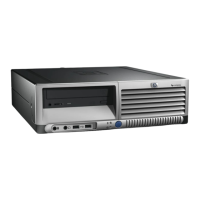14 www.hp.com Desktop Management Guide
Desktop Management Guide
❏ search removable media for BIOS image files. If an
appropriate BIOS image file is found, it is automatically
flashed into the ROM.
❏ start the system from bootable removable media that
automatically invokes system BIOS upgrade utilities.
When an invalid system BIOS image is detected, the system power
LED will blink red 8 times, one blink every second. Simultaneously,
the speaker will beep 8 times. If the portion of the system ROM
containing the video option ROM image is not corrupt, "Boot Block
Emergency Recovery Mode" will be displayed on the screen.
To recover the system after it enters Boot Block Emergency Recovery
Mode, complete the following steps:
1. Turn off the power.
2. Insert a diskette, CD, or USB flash device containing the desired
BIOS image file in the root directory. Note: The media must be
formatted using the FAT12, FAT16, or FAT32 file system.
3. Turn on the computer.
If no appropriate BIOS image file is found, the failsafe Boot
Block BIOS will attempt to start the system from a bootable
device. If no bootable device is found, you will be prompted to
insert media containing a BIOS image file or BIOS upgrade
utility.
If the system successfully reprograms the ROM, the system will
automatically power off.
4. Remove the removable media used to upgrade the BIOS.
5. Turn the power on to restart the computer.
Replicating the Setup
The following procedures give an administrator the ability to easily
copy one setup configuration to other computers of the same model.
This allows for faster, more consistent configuration of multiple
computers.
✎
Both procedures require a diskette drive or a supported USB flash
media device, such as an HP Drive Key.

